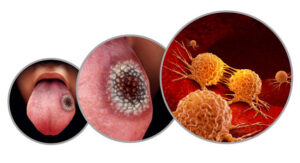Step-By-Step Oral Cancer Screening
April 27, 2024
 Cavities and gum disease aren’t the only issues that can be hidden in your mouth. 54,000 Americans are diagnosed with oral/oropharyngeal cancer every year. It accounts for 9,750 deaths annually. That’s roughly 1 person every 24 hours. Contrary to what you might have heard, you don’t have to be a smoker to be at risk. It’s important to have an oral cancer screening regularly. You can benefit from early detection by visiting your dentist every 6 months for a cleaning and checkup. Your dentist can perform a screening during your semi-annual appointment. Here’s what you can expect during your screening.
Cavities and gum disease aren’t the only issues that can be hidden in your mouth. 54,000 Americans are diagnosed with oral/oropharyngeal cancer every year. It accounts for 9,750 deaths annually. That’s roughly 1 person every 24 hours. Contrary to what you might have heard, you don’t have to be a smoker to be at risk. It’s important to have an oral cancer screening regularly. You can benefit from early detection by visiting your dentist every 6 months for a cleaning and checkup. Your dentist can perform a screening during your semi-annual appointment. Here’s what you can expect during your screening.
Who Needs an Oral Cancer Screening?
Everyone should have an oral cancer screening, even if you don’t have any risk factors, like smoking or heavy alcohol consumption. Despite being treatable, the U.S. 5-year survival rate for oral cancer is 64.3%. Late diagnosis is a prevalent contributor to the mortality rate. Researchers report that 80% of new oral cancer cases can be diagnosed early through routine dental care.
Oral Cancer Screening Process
While examining your teeth and gums, your dentist will also take a look for any signs of oral cancer. It consists of a visual and physical examination to look for anything concerning. They will look at your gums, tongue, palate, and soft tissues. Your dentist will examine your neck, lips, the inside of your nose, and your face. You’ll need to remove any oral appliances, including dentures and retainers, to ensure your dentist can examine everywhere in your mouth.
Your dentist will keep an eye out for any lumps, bumps, or swelling. They’ll check for any white, rough, or sore patches, which are signs of oral cancer. They’ll use a small light and mirror to ensure nothing is overlooked.
During the physician exam, your dentist will touch your cheeks, jaw, head, under your chin, and inside the oral cavity to feel for any nodules or masses. They’ll also test the mobility of your tissues and check for painful spots. Some dental practices use additional methods, like a technological tool that can detect precancerous cells that aren’t visible to the naked eye. Your dentist will review their findings and discuss if any additional procedures are needed.
An oral cancer screening only takes a few minutes. It’s time well-spent to benefit from early detection, if the worst should happen. Don’t hesitate to ask your dentist any questions you might have. They’ll take time to explain everything, so you know exactly what to expect during your screening.
About Dr. Mark Stapleton
Dr. Stapleton earned his dental degree from the University of Minnesota School of Dentistry and has completed additional training in various specialties, like restorative dentistry, dental implants, and cosmetic dentistry. He is affiliated with the American Dental Association and many other professional organizations. Request an appointment through his website or call his office at (952) 314-7380.
No Comments
No comments yet.
RSS feed for comments on this post.
Sorry, the comment form is closed at this time.
